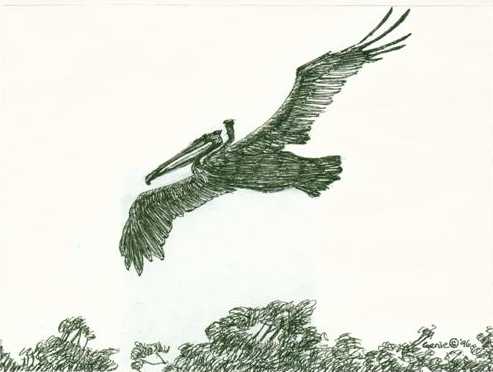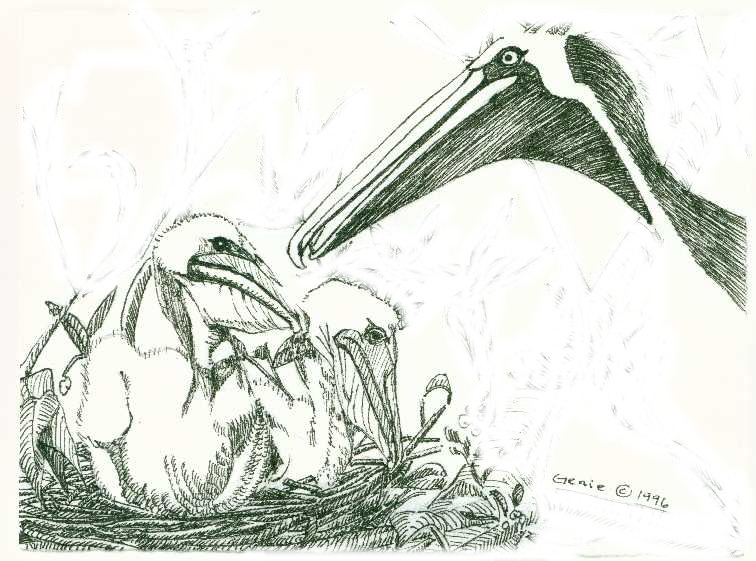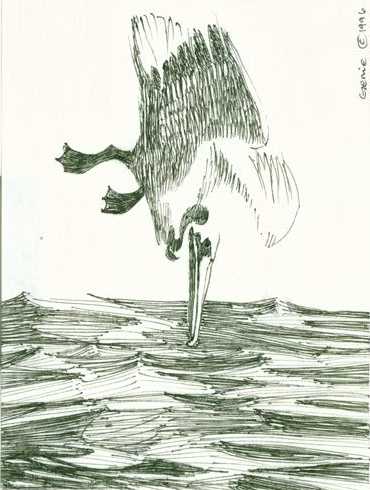It's not Easy Being a Pelican
 By
Evelyn Dabritz
By
Evelyn Dabritz
DDabritz@[remove]aol.com
Cayucos, CA
Mr. Pelican circled the island just off the coast of California. With his great
wings which spread over six feet, he skillfully rode the air currents gliding
and using a powerful stroke only now and then. Winter is the time of the year
when brown pelicans return to the colony. Hundreds of other brown pelicans
were already there claiming nests. He saw an area where several nests had not been
taken. Touching down gracefully, he folded his wings and
waddled clumsily. There were hollowed mounds of dirt, sea weed, grasses, and
twigs left over from previous years. Here was one several inches high that would
need only a few repairs. He knew Mrs. Pelican would be happy when she saw it.
When Mrs. Pelican flew in, she was attracted by Mr. Pelican’s wonderful display. She sat for a while admiring the way he moved his head back and forth sideways
in a figure eight. Finally she waddled over to greet him. Their meeting was very
serious and quiet since adult pelicans make very few sounds. Their joy was shown
with head and body movements.

Illustration by Genie Over
What a handsome couple they made, feathered in their brightest colors for this
courtship time. Their heads were bright yellow. The skin around their yellow
eyes was bright pink. Their enormous beaks were shades of orange with a black
pouch hanging below. White necks, grayish- brown backs and wings, and black
bellies completed their colorful dress. They were beautiful to each other, even
if they might seem a bit comical to other creatures. It was a time for just
enjoying each other’s company.
Enough of that, it was early Spring and time to work on the nest. Mr. Pelican
flew off and soon returned with a twig that he presented to Mrs. Pelican as a
loving gift. She accepted the twig as if it was a bouquet of flowers and worked
it into just the right place. Mr. Pelican returned again and again with twigs,
grasses, and even sea weed. Mrs. Pelican worked hard shaping the nest and making
it cozy. They made sure that neighboring nests were no closer than an
outstretched bill. With other couples so close, it was important to guard the
nest from pelicans too lazy to get their own nesting materials. They snapped
their bills and flapped their wings when it was necessary to discourage “nestnappers”.

Illustration by Genie Over (edited)
What a happy day it when Mrs. Pelican laid her first chalky, white egg. Two days
later a second egg arrived, and then a third. It was full time duty for the
proud parents. They took turns sitting on the nest. The eggs had to be shaded
from the hot sun and protected from the gulls who robbed nests. One day Mrs.
Pelican stood up to stretch a bit. Before she knew what was happening, a greedy
gull swooped down and snatched one of the eggs.
One could tell that it was almost time for the eggs to hatch by looking at the
changing colors of the parents. Their bright yellow heads were turning white and
their necks were turning a dark, chocolate brown. Their yellow eyes even turned
to brown. These complicated color changes continuing through the year make
pelicans fashion leaders in the bird world. After chicks leave the nest, adult
colors change again, and molting replaces old, shabby feathers.
After nearly a month of incubating, the first egg cracked and out flopped an
ugly, naked, blind, helpless girl chick.
Mr. Pelican looked anxiously at the new arrival. “Oh, my dear, do you think
she’s all right?”
“Don’t worry, Dear, she’ll be stronger when she gets lots of food. Just give her
a couple of weeks and that ugly, gray, wrinkled skin will be covered with a soft
white down,” assured Mrs. Pelican.
“What shall we name her?” asked Mr. Pelican.
“Patty Pelican has a good ring. You had better go fishing for her first meal!”
said Mrs. Pelican excitedly.
Mr. Pelican took off and soon returned. “What do I do now, Mrs. Pelican?”
“Just drizzle some of your partially digested fish down your bill and into
hers,” instructed Mrs. Pelican.
Mr. Pelican finally got his big bill in position and patiently dribbled food
into Patty’s tiny bill. It was all Patty could do to finish her meal. She fell
back into a sound sleep.
“This isn’t easy!” said Mr. Pelican, somewhat flustered.
“Just be patient. Soon her eyes will be open, and she’ll be able to grab
food with her own bill when we drop it in the nest,” encouraged Mrs. Pelican.
In two more days the second egg hatched and a little boy chick flopped out
equally ugly and helpless.
It was Mr. Pelican’s turn to think of a name. “Let’s call him Paul. Yes, Paul
Pelican sounds just right.”
By now, the usually quiet nesting colony was alive with the loud screaming,
grunting, and clucking of hundreds of chicks begging for food. The sky was
filled with pelican parents gliding in and taking off. Noisy gulls darted in and
out trying to grab eggs and chicks. Patty and Paul added their shrill cries for
food. Now, when a parent brought in food, they pushed and flapped their wings
trying to be the first to be fed. It looked like they were being swallowed as
they grabbed fish out of those big bills. Paul was much smaller than Patty, but
he was soon able to hold his own in the scramble for food.
The noise was bad enough for the hard working parents, but sometimes neighboring
chicks waddled into their nest begging and shrieking. “Why can’t our neighbors
keep those begging babies at home?” complained Mr. Pelican. “This noise is
enough to give us headaches.”
In ten weeks Patty and Paul were bigger than their parents. They still had white
bellies, but their backs, heads, and necks had turned brown. Feathers had
replaced the down.
The weary parents had a hard time supplying two to three pounds of fish a day
for each chick. To satisfy their own appetites each parent needed about four
pounds of fish a day, also. Sometimes they had to fly twenty to thirty miles to
find good schools of fish.
“It won’t be long until you’ll be catching your own fish,” said Mr. Pelican
hopefully.
“Be sure to exercise your wings,” advised Mrs. Pelican. “You are beginning to
look grubby. You’ll never be able to fly if you don’t take better care of your
feathers. Use the hook on your bill to preen your feathers. For the feathers you
can’t reach use that special hook you have on your third toe.”
Patty was ready for her first flight. She flapped her wings, pushed off with her
feet, and rose above the colony. “Whee, this is fun!” she thought. “Oh, look at
the view! It’s so peaceful away from all of that noise and no little brother to
pester me.” She circled and realized that she would have to land sometime. Down,
down she glided as the nesting area rose to meet her. “This is not easy,” she
thought as her feet wobbled back and forth. Bam! She crashed into a ledge on the
cliff. Several gulls shrieked with laughter as she picked herself up and
straightened her ruffled feathers.
Paul had been watching his sister’s first attempt. This made him even more
nervous about flying, but he was determined. “Well, here goes!” he said bravely.
Soon he, too, was experiencing the thrill of soaring and gliding above the
colony. His landing was even fairly smooth.
“Patty, let’s join that group flying over to the next island. We sure need the
practice,” called Paul. “Look, they are flying in a V formation.”
They took positions near the back of the V trying hard to keep the correct
distance and time their wingbeats. It wasn’t easy, but the leader was very
patient. Next, it was time for Follow the Leader. They flew down single file as
their line curved and dipped just over the waves.
“Just feel the lift of the wave. We hardly have to flap,” called Paul happily.
Suddenly, the wave broke catching Paul and slamming him into the surf. After
tumbling around a bit, he popped right up and paddled along. Before the next
wave caught him, he managed to struggle back into the air.
Paul and Patty were tired, but very excited about their experiences. Suddenly,
Paul said, “I’m getting hungry! Where are Mom and Dad?”
“Don’t you remember? They said it was time for us to catch our own fish,” Patty
called.
“You mean they’re not going to help us anymore? That diving looks awfully hard
to do,” said Paul nervously.

Illustration by Genie Over
“Silly, just watch me. It can’t be that hard. We’ve been watching pelicans dive
every day,” Patty yelled as she climbed upward where she could look for a school
of fish.
Patty was gliding along about twenty feet above the water when she spotted
several fish just under the surface of the water. “If only I can remember how
other pelicans do this,” she thought trying to picture the correct moves. She
slowed, then plunged down with her wings spread out. At the last moment before
she hit the water, she folded her wings back halfway, stretched out her neck,
and shot her feet back. Splat! She hit the water with a big splash.
“Oh, that hurt!” she cried, holding her neck a little to the side. Not even her
special air sacks had cushioned her head enough that time. There was no fish,
either.
Paul said, “I don’t think I can do that.”
“Well, you had better try,” said Patty. “Mother said we might have to go live
with the white pelicans if we don’t learn to dive. They don’t even know how to
dive. They just swim around and scoop up the fish.”
“Well, I don’t want to do that. It’s not easy being a brown pelican, but I’ll
hang in there and try,” said Paul bravely.
When Paul managed to overcome his fear, he flew above the water and spotted some
fish. It was a perfect dive! He opened his bill, netted a fish, and turned
completely over under the water. “I got one! I got one!” he thought excitedly. He righted himself, pointed his bill down, and was draining nearly two gallons
of water from his elastic pouch. Just as he was opening his bill to turn the
fish around, a gull swooped down and grabbed his fish.
“Thanks for the fish!” taunted the thieving gull as it sped away.
Poor Paul could only watch as his fish disappeared down the gull’s throat.
“Oh, I’m really hungry now,” said Patty. “I don’t see any more fish, and I’m too
tired to try diving again.”
“Oh, look down there, Patty! There’s a boat throwing out fish scraps. Let’s fly
over there!” called Paul.
The two hungry chicks flew down near the boat and scooped up fish scraps as the
fishermen cleaned fish. It wasn’t long until both chicks were full.
“I wish we could take back some of these scraps in our bills,” said Patty, “but
I know we can’t take off with full pouches.”
“That was lucky! We’ll have to try fishing again tomorrow. There won’t always be
a fishing boat to follow. We won’t give up,” said Paul.
They worked at diving the next day and finally managed to catch one fish each. As time went on they were able to catch fish more often in their dives. They
found that they could fly near the surface of the water and occasionally scoop
up a fish with a shallow dive. Patty and Paul lost weight, but their fishing
skills were improving daily. At last they were rewarded with a fish on almost
every dive.
Patty and Paul decided to join a group of young pelicans who were going over to
the mainland. They flew away from their little island on a new adventure. It
isn’t easy being a pelican, but they had passed the test for survival. They
would never be lonely because of pelican togetherness. There would always be
flocks of pelican friends for flying, fishing, nesting, or loafing. Winter would
bring them back to the island colony. In about three years they would be raising
their own families.
©1996 Evelyn Dabritz
Docent Dick Evans has told this story at the Morro Bay
Bird Fest and to children on school tours at the Morro Bay museum.
Go to
Docent Pages Index
morro-bay.com home
More Evelyn Dabritz writings
 By
Evelyn Dabritz
By
Evelyn Dabritz

